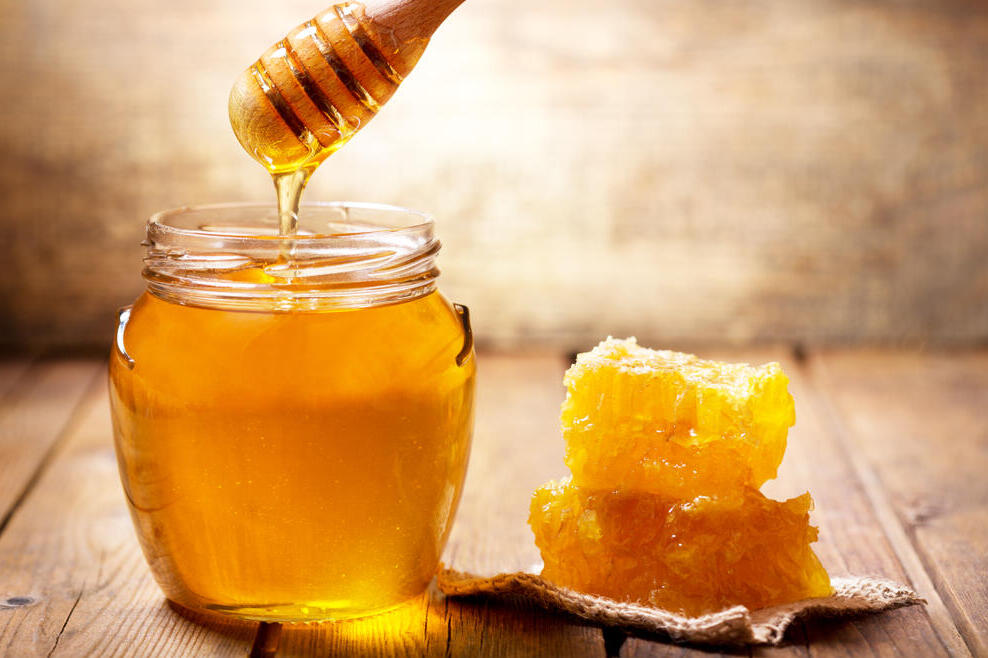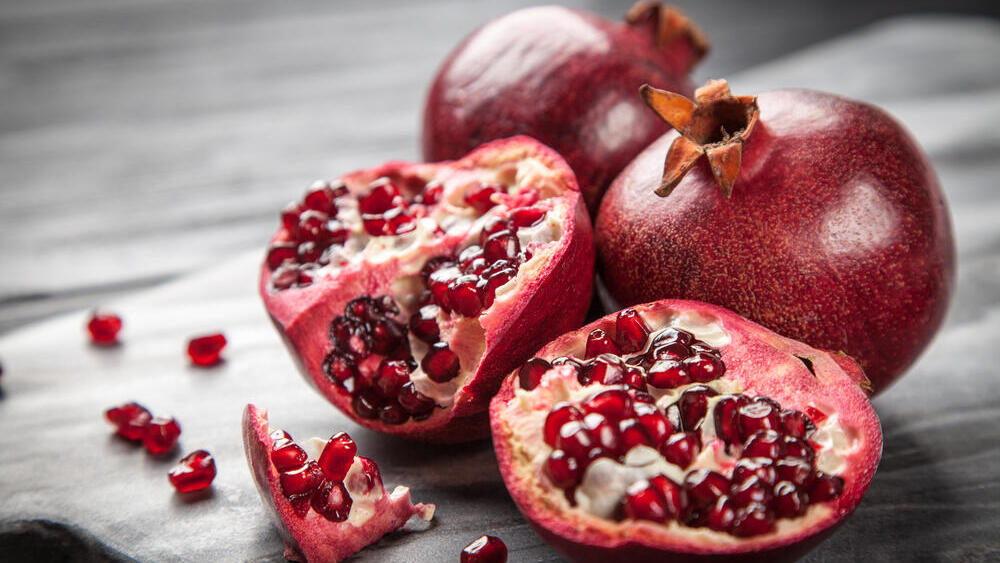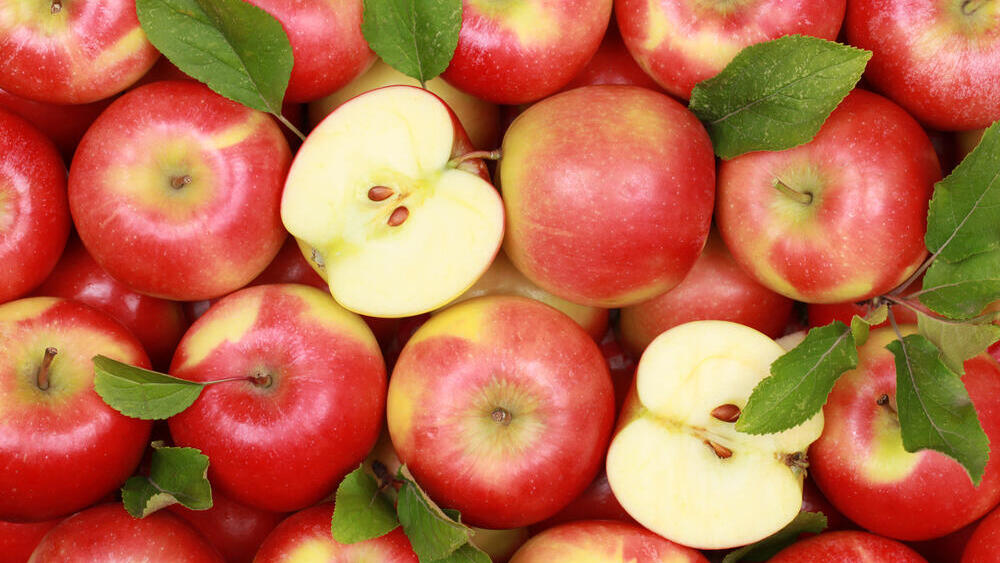Getting your Trinity Audio player ready...
"Holiday foods" is a misleading concept, because it makes it sound as if we cannot eat them on normal days. But when it comes to foods that are on the table at the high holidays, it is worthwhile and even recommended to eat them all year round.
Read more:
Pomegranate: drink the juice or eat the whole fruit whole?
Many studies show the benefits of eating pomegranate and drinking pomegranate juice. The pomegranate contains important vitamins and minerals such as vitamin C and folic acid as well as potassium and polyphenolic compounds that help fight inflammation and chronic diseases such as cancer, heart disease and type 2 diabetes.
From a metabolic standpoint, eating the whole fruit is better than drinking juice, even if it is natural, since the amount of sugar found in each glass of juice, its slow absorption and the lack of essential components that are present in the fruit itself but not in the juice are linked to negative metabolic effects.
It is always preferable to eat the whole fruit, but it is important to know how the pomegranate affects the sugar in the body. You can check the effect of any food on sugar using a glucometer or a continuous sugar monitor. Experience shows that a variety of fruits, including pomegranate, have a positive effect on sugar as long as you strictly control the amount of the fruit that you eat. If you add fat to the fruit - for example, a handful of almonds or nuts - this may have a positive effect on the breakdown rate of the sugar and its absorption in the blood. FYI: A half a small pomegranate (about 100 grams) contains about 19 grams of carbohydrates.
Apple: Is green better than red for diabetics?
Apples are rich in dietary fiber and polyphenols (antioxidants). The fibers increase the volume of food passing through the intestine and thus increase the feeling of satiety and improve the activity of the digestive system. The polyphenols in the apple are linked to preventing diseases such as cancer and maintaining cognition and memory, and have a beneficial effect on the heart, blood pressure, muscles and liver.
Diabetics who love honey and wish to consume it on a daily basis should examine its effect on their sugar level. Remember that honey is considered a simple carbohydrate, and its sugar is usually absorbed quickly into the bloodstream.
The prevailing myth is that a sour green apple has less sugar than a red apple, so it is better for diabetics. This is a mistake; Apples of all colors contain the same amount of sugar. The apple can have a positive effect on the blood sugar level or raise it significantly depending on its size and the additional food you eat. Large apples, weighing close to 200 grams, constitute two servings of fruit, and the amount of sugar in them is greater. Try to look for the smaller apples and eat one apple at a sitting. Combining fat such as almonds or nuts with the fruit or before eating it can lead to a better sugar level.
Which is better: honey or sugar?
High quality and real honey is a natural food and contains 80% carbohydrates. In contrast, white or brown sugar is a processed food and contains 100% carbohydrates. There is no doubt that honey has nutritional values that do not exist in sugar, but to gain them, you have to eat a large amount of it, and this is not recommended due to its high sugar content.
5 View gallery


honey has nutritional values that do not exist in sugar, but to gain them, you have to eat a large amount of it
(Photo: Shutterstock)
Diabetics who love honey and wish to consume it on a daily basis, should examine its effect on the sugar level. It should be remembered that honey is considered a simple carbohydrate, and its sugar is usually absorbed quickly into the bloodstream.
Regarding how much is not too much - proportionality is the name of the game. It is important to plan well when to eat honey, with what (it is recommended to be accompanied by additional food ingredients such as protein or fat in order to moderate the rise in blood sugar) and in what quantity. Either way, it is recommended that the consumption of honey be as small as possible, because in significant quantities it may increase the level of triglycerides in the blood and increase the amount of fat in the liver, beyond its effect on blood sugar levels.
Fish: which fish is the healthiest?
We have always thought that North Sea fish (salmon, sardines, tuna, sole, halibut) are the most recommended due to their omega-3 content. Today it can be said with certainty that the composition of pond fish in Israel has changed for the better, and certain fish such as mullet, trout and perch also contain a significant amount of omega-3.
Fish have many health benefits, and these benefits have been unequivocally proven. No wonder they star in the Mediterranean diet, which is known to reduce the risk of cardiovascular diseases. The fish are low in saturated fatty acids and cholesterol and rich in quality protein. Some are also rich in vitamins B12 and D. According to the new dietary recommendations of the Health Ministry, it is recommended to consume fish at least once a week, meaning fresh or frozen fish and not salted or smoked fish.
Black-eyes peas: How to incorporate it into the menu?
Due to its strong resemblance to green beans, many are not familiar with black-eyed peas. In practice, there are three main differences between them: the stalk of the black-eyed peas is thinner and narrower than that of the green bean; Green bean seeds have a "black eye"; And green beans are sweeter.
Black-eyed peas belongs to the legume family, are rich in protein and soluble dietary fiber and also in complex carbohydrates that are absorbed into the blood slowly in some people, which means they will raise blood sugar level moderately. One hundred grams of green beans contain 21 grams of carbohydrates, of which 7 grams are dietary fiber, so the amount of carbohydrates available to break down into sugar will be smaller. Since green beans are richer in carbohydrates compared to other vegetables, diabetics are recommended to include them in the meal as the carbohydrate portion, just like rice, potato and pasta.
Beets: Why is it important to include purple vegetables as well?
You may have already been told of the recommendation to eat vegetables and fruits of five different colors a day. This is important because the substances that color the vegetables and fruits, called pigments, have far-reaching health effects. We will focus on the color purple. The substances that give beetroot its color are called betalains, and they have a tremendous effect on reducing inflammation in the body. Another important component in beets is nitrite, which helps expand blood vessels and can lead to a drop in blood pressure. Beets are also rich in many vitamins and minerals: vitamins B, A, C, iron, magnesium, folic acid, calcium, phosphorus and potassium.
Eating beetroot or drinking its juice can also help those suffering from constipation, and even though beetroot is sweet, diabetics can incorporate it into their meal in a moderate amount. Some 100 grams of beets (about half a cup) contain about 8 grams of carbohydrates (equivalent to about half a slice of bread). Swiss chard (beetroot) can be used as a substitute for regular beetroot with fewer carbohydrates.
Pumpkin: Why is it good for eye health?
Good news for diabetics: pumpkin is the lowest in carbohydrates compared to all other orange vegetables (including kelp). Its orange color is an important antioxidant that contains beta-carotene (vitamin A) that helps maintain the health of the eyes and the immune system, protects the body's cells and slows down the aging process. Pumpkin is also rich in many vitamins and minerals such as zinc, potassium, iron, calcium, magnesium and selenium, and dietary fiber. Some 100 grams of pumpkin contain 37 calories and 6 grams of carbohydrates. It is recommended to include pumpkin in the meal as a side dish instead of sweet potato or potato.
Dates are a natural candy
The date is a fleshy and special fruit that is considered a natural candy. Dates contain a large amount of potassium that helps reduce blood pressure and relax the body's muscles. They go great in a shake and also on their own as a source of energy, for example, before physical activity. The date is rich in carbohydrates, and for a significant number of people it has a high glycemic index – which means that it is digested and absorbed into the blood quickly and raises the sugar level quickly.
5 View gallery


Dates contain a large amount of potassium that helps reduce blood pressure and relax the body's muscles
(Photo: Sagi Moran)
It is not recommended to consume dates in large quantities and combine them with yogurt or any fat in order to keep sugar levels balanced. Delicious tip: open the dates, remove the pit, put a little natural peanut butter (fat) inside, refrigerate for a few hours and eat. A portion of dates consists of two small dates or one large date (20 grams) equal to 60 calories and 15 grams of carbohydrates. It is recommended to check the effect of the date on your sugar level.
The author is a diabetes dietician at the obesity clinic at the DMC Diabetes Center




